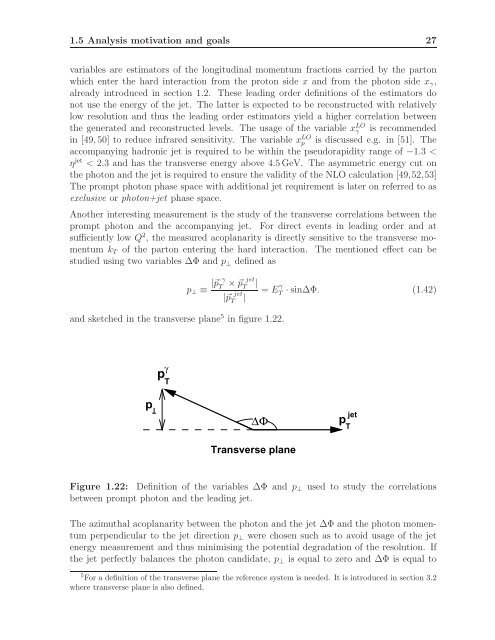10 - H1 - Desy
10 - H1 - Desy
10 - H1 - Desy
You also want an ePaper? Increase the reach of your titles
YUMPU automatically turns print PDFs into web optimized ePapers that Google loves.
1.5 Analysis motivation and goals 27<br />
variables are estimators of the longitudinal momentum fractions carried by the parton<br />
which enter the hard interaction from the proton side x and from the photon side x γ ,<br />
already introduced in section 1.2. These leading order definitions of the estimators do<br />
not use the energy of the jet. The latter is expected to be reconstructed with relatively<br />
low resolution and thus the leading order estimators yield a higher correlation between<br />
the generated and reconstructed levels. The usage of the variable x LO<br />
γ is recommended<br />
in [49,50] to reduce infrared sensitivity. The variable x LO<br />
p is discussed e.g. in [51]. The<br />
accompanying hadronic jet is required to be within the pseudorapidity range of −1.3 <<br />
η jet < 2.3 and has the transverse energy above 4.5 GeV. The asymmetric energy cut on<br />
the photon and the jet is required to ensure the validity of the NLO calculation [49,52,53]<br />
The prompt photon phase space with additional jet requirement is later on referred to as<br />
exclusive or photon+jet phase space.<br />
Another interesting measurement is the study of the transverse correlations between the<br />
prompt photon and the accompanying jet. For direct events in leading order and at<br />
sufficiently low Q 2 , the measured acoplanarity is directly sensitive to the transverse momentum<br />
k T of the parton entering the hard interaction. The mentioned effect can be<br />
studied using two variables ∆Φ and p ⊥ defined as<br />
p ⊥ ≡ |⃗p γ<br />
T<br />
× ⃗p<br />
jet<br />
T<br />
|<br />
|⃗p jet<br />
T<br />
|<br />
= E γ T<br />
· sin∆Φ. (1.42)<br />
and sketched in the transverse plane 5 in figure 1.22.<br />
p<br />
γ<br />
T<br />
p<br />
∆Φ<br />
Transverse plane<br />
p<br />
jet<br />
T<br />
Figure 1.22: Definition of the variables ∆Φ and p ⊥<br />
between prompt photon and the leading jet.<br />
used to study the correlations<br />
The azimuthal acoplanarity between the photon and the jet ∆Φ and the photon momentum<br />
perpendicular to the jet direction p ⊥ were chosen such as to avoid usage of the jet<br />
energy measurement and thus minimising the potential degradation of the resolution. If<br />
the jet perfectly balances the photon candidate, p ⊥ is equal to zero and ∆Φ is equal to<br />
5 For a definition of the transverse plane the reference system is needed. It is introduced in section 3.2<br />
where transverse plane is also defined.
















